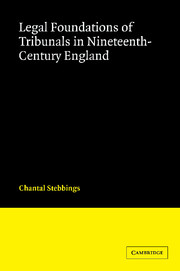Book contents
- Frontmatter
- Contents
- Acknowledgements
- Table of statutes
- Table of cases
- List of abbreviations
- 1 Challenges to the legal process
- 2 The ideological and theoretical context
- 3 Composition and personnel
- 4 Jurisdiction and functional powers
- 5 Procedure and practice
- 6 Judicial supervision
- 7 Principles, place and perception
- Index
7 - Principles, place and perception
Published online by Cambridge University Press: 02 December 2009
- Frontmatter
- Contents
- Acknowledgements
- Table of statutes
- Table of cases
- List of abbreviations
- 1 Challenges to the legal process
- 2 The ideological and theoretical context
- 3 Composition and personnel
- 4 Jurisdiction and functional powers
- 5 Procedure and practice
- 6 Judicial supervision
- 7 Principles, place and perception
- Index
Summary
On the eve of the Great War, an event in world history that was to change social and economic conditions in Britain as radically as the industrial revolution that had opened Victoria's reign, the legal and political system found that it had created a new institution. For over eighty years the statutory tribunal had effectively addressed the considerable problems to which the industrial revolution had given rise. Indeed it was a body that was to endure to meet radically changing conditions into the future and to become one of the major legal institutions in Britain, challenging the traditional courts of law in terms of numbers of disputes heard and determined. In 1914 there were a number of such bodies, extra-judicial administrative organs possessing limited judicial powers, bodies that are today known as statutory, or administrative, tribunals. To the modern legal eye they are instantly recognisable as examples of a hybrid species of dispute-resolution body hovering somewhat uncertainly between the judicature and the executive. From their inception, these bodies had clear common features in their personnel, procedures and broad function, because their requirements were in essence the same whatever the nature of the legislation they were created to implement. All required speed, efficiency, cheapness and a specialist composition. It has been seen that the regular courts could not be adopted wholesale for the implementation of the new legislation, not only because of the inherent shortcomings of personnel and process, but also because the new reforming legislative codes required more than an instrument of dispute-resolution.
- Type
- Chapter
- Information
- Legal Foundations of Tribunals in Nineteenth Century England , pp. 273 - 334Publisher: Cambridge University PressPrint publication year: 2007

